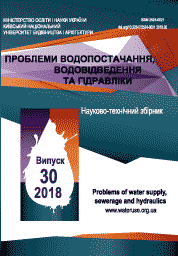The study on the relationships between coliphages and viral and bacterial contamination of drinking water in the city’s water distribution system
DOI:
https://doi.org/10.32347/2524-0021.2018.30.23-30Ключові слова:
somatic coliphage, hepatitis A virus antigen, total coliform bacteria, drink water, chlorinated waterАнотація
Water supply is one of the main ways of spreading dangerous infectious diseases. Inefficient technologies of water treatment and the emergency condition of urban water supply and sewage networks lead to microbiological contamination of tap water causing of massive outbreaks of acute intestinal infections in the population. To prevent such situations continuously monitor the microbiological quality of drinking water using indicators of water faecal contamination is necessary. Total coliform is the most common method of microbiological control water quality. The outbreaks of infectious diseases in the absence total coliform in water are required the additional indicators for monitoring. In the EU countries, in 2018, the somatic coliphage was introduced as indicator of drinking water quality. This virus of E.coli is a clear indicator of faecal water contamination. The water supply laboratories are using the methods of determining the coliphages now. The results of measurements are taken to the assessment of microbiological safety and water quality. But the high percentage of non-standard water samples for this indicator requires further research into its significance in the practical operation of water utilities. The long-term dynamics of microbiological indicators of water quality (coliphages, hepatitis A virus antigen and total coliform) in chlorinated tap water from the city’s water supply system is investigated in the article. The absence of the correlation of the coliphages with the hepatitis A virus antigen and the total coliform is established.Посилання
Begadilova, T.S., Ramazanova, B.A., Bisekenov, A.L., Mustafin K.K., Barmakova, AM, Urumbaeva, S.Sh. Sadyrova, A.А. (2010). Poyvlenie kolifagov u donoshenih i nedonoshenih novorogdennih detey v zavisimosti ot vida vskarmlivaniy. The appearance of colophagus in premature and premature newborn infants depending on the type of feeding. Retrieved from http://www.rusnauka.com/ 28_OINXXI_2010 / Medecine / 72639.doc.htm [in Russian].
Chistovich, G.N. (1970). Bаkteriofahi, deystvuyushchie na kishechnye bakterii. Bacteriophages acting on intestinal bacteria. Sanitarnay mikrobiologiy. Sanitary microbiology. 356. [in Russian].
Jeong, H., Barbe, V., Lee, C.H., (2009). Genome sequences of Escherichia coli B strains REL606 and BL21(DE3). J. Mol. Biol., 644-652. doi:10.1016/j.jmb.2009.09.052
Jofre, J., Lucena, F., Blanch, A.R., Muniesa, M., (2016). Coliphages as Model Organisms in the Characterization and Management of Water Resources. Water, 8(5), 199. doi:10.3390/w8050199
Guidelines for the sanitary-virological control of environmental objects (1982). Moscow. 75. [in Russian].
Guidelines for the study of water factor in the incidence of the population of viral hepatitis A (1986). Moscow. [in Russian].
Unified methods for the study of water quality. Part IV. Microbiological methods (1985). Moscow. [in Russian].
Okeyo, A., Coetzee, M., Momba, M. N. B., (2013). Use of coliphages to evaluate water treatment processes and determine faecal contamination origin of source waters Int. J. Environ. Sci. Technol., 10(6), 1225–1234. doi:10.1007/s13762-013-0289-x
Maksimova, E. E., Kolotilo, V. D., Kobylyansky, V. Ya. Starodubov, A. G., Kovrevskya, M. M., (2004). On the value of coliphages in the assessment of water pollution by the hepatitis A virus. Scientific Bulletin of Construction, 28, 72-77. [in Ukrainian].
Rakhmanin, Yu. A., Nedachin, A. E., Doskina, T. V., Kornilova, N. M., Dmitrieva, R. A., Sharlot, Yu. M. (1990). Indikatornaya znachimost kolifagov v otnoshenii zagryazneniya pityevoy vody kishechnymi virusami. Indicator significance of coliphages with respect to contamination of drinking water with intestinal viruses. Hihiena i sanitariya – Hygiene and Sanitation. 6. 21-23.
Peterson, D. A., Hurley, T. R., Hoff, J. C. [et al.] (1983). Effect of chlorine treatment on infectivity of hepatitis A virus. Applied and environmental microbiology. 45(1). 223–227.
Hajenian, H. G., Butler, M., (1980). Inactivation of viruses in municipal effluent by chlorine. Journal of Hygiene, 84(1), 63-69. doi:10.1017/s0022172400026528
Odom, R., Rotert, K., (2006). Distribution System Indicators of Drinking Water Quality. EPA US., Retrieved from http://www.epa.gov/safewater/disinfection/tcr/index.html
Lechevallier, M. W., Karim, M.W.M.R., Weihe, J., Rosen, J.S., and Sobrinho, J., (2006). Coliphage as a potential indicator I of distribution system integrity. JAWWA, 98(7), 87-96. doi:10.1002/j.1551-8833.2006.tb07713.x
Maksimova, E. E., Kolotilo, V. D., Kobylyansky, V. Ya. Starodubov, A. G., (2004). Features of sea-sonal dynamics of coliphages in drinking water. Kommunalne hozyaystvo gorodov, 55, 19-28. [in Ukrainian].
Allen, J., Dickerson, J. and Gooch-Moore J. (2009). Evaluating the Potential for Somatic Coliphage Replication in Envi-ronmental Waters. Retrieved from https://www.musc.edu/mbes-ljg /MBESOpenHouse/sroh2009/abstracts/Allen.pdf.
Jebri, S., Muniesa M. & Jofre J., (2017) General and host-associated bacteri-ophage indicators of faecal pollution. In Global Water Pathogen Project. . doi:10.14321/waterpathogens.7
Kostyuchenko, S.V., Volkov, S.V., Ya-kimenko, A.V., Mazaev, V.T., Shishov, S. Yu. Obbezzaragivanie pri podgotovke vody iz poverhnostnyh istochnikov. Disinfection during preparation of water from surface sources Retrieved from http:// www.waterland.ru /sfwp-oppvipi.
Review of Coliphages as Possible Indi-cators of Fecal Contamination for Ambient Water Quality. Retrieved from https://www.epa.gov/sites/production/files/2016-07/documents/review_of_coliphages_as _possible_indicators_of_fecal_contamination_for_ambient_water_quality.pdf.
Salter, R. (09/8/2012). Testing Drinking Water for Coliphage as a Fecal Quality Indicator: Advances in Rapid Coliphage Detection. Retrieved from https://www.charm.com/wp-content/uploads /2018/06/MRK-108.pdf
##submission.downloads##
Опубліковано
Як цитувати
Номер
Розділ
Ліцензія
Автори, які публікуються у цьому журналі, погоджуються з наступними умовами:
a) Автори залишають за собою право на авторство своєї роботи та передають журналу право першої публікації цієї роботи, яка через 70 років після смерті останнього співавтора з дати публікації автоматично стає доступною на умовах ліцензії Creative Commons Attribution License, котра дозволяє іншим особам вільно розповсюджувати опубліковану роботу з обов'язковим посиланням на авторів оригінальної роботи та першу публікацію роботи у цьому журналі.
b) Автори мають право укладати самостійні додаткові угоди щодо неексклюзивного розповсюдження роботи у тому вигляді, в якому вона була опублікована цим журналом (наприклад, розміщувати роботу в електронному сховищі установи або публікувати у складі монографії), за умови збереження посилання на першу публікацію роботи у цьому журналі.
c) Політика журналу дозволяє і заохочує розміщення авторами в мережі Інтернет (наприклад, у сховищах установ або на особистих веб-сайтах) рукопису роботи, як до подання цього рукопису до редакції, так і під час його редакційного опрацювання, оскільки це сприяє виникненню продуктивної наукової дискусії та позитивно позначається на оперативності та динаміці цитування опублікованої роботи (див. The Effect of Open Access).


